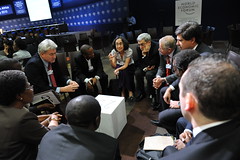 Image by MikeOliveri via FlickrBrainstorming is a method for rapidly gathering ideas from a group. These ideas can help individuals in the group solve problems and discover solutions. Brainstorming sessions allow members to express their ideas and creativity, and to discover connections between ideas and participants. There are marginalized voices in your class or organization that have something unique to contribute. Brainstorming can help bring forth these voices from the back of the room. By their nature, brainstorming sessions allow everyone to have an equal voice.
Image by MikeOliveri via FlickrBrainstorming is a method for rapidly gathering ideas from a group. These ideas can help individuals in the group solve problems and discover solutions. Brainstorming sessions allow members to express their ideas and creativity, and to discover connections between ideas and participants. There are marginalized voices in your class or organization that have something unique to contribute. Brainstorming can help bring forth these voices from the back of the room. By their nature, brainstorming sessions allow everyone to have an equal voice.Ordo ab Chaos: Six Rules for Brainstorming Sessions:
- Suspend criticism and judgment.
Everyone must agree to accept all answers; there is no good or bad idea. For five minutes, everyone is brilliant. Reviewing and sorting of the ideas will come later. - Wild is permitted.
Wild is good. Wild ideas give birth to great ideas. - Quantity not quality.
The more ideas you can work from the better. - Everyone participates.
All and any ideas will contribute to the whole. There are no bosses or teachers in a brainstorm. - Invent and recycle.
Utilize ideas already stated and combine them with others. Do not fear your creative voice. - Record everything.
Let people call out their ideas, but if the ideas are not written down, people will forget what was said. Use a white board or a computer projector. Misspelling, shorthand, and doodling are acceptable. Suspend criticism of the recording process as well; this is a creative process.
Guidelines for facilitating a brainstorming session:
- Schedule a brainstorming session during a regularly scheduled meeting or class time. The participants will appreciate the added interaction.
- Have the group or class help define the brainstorming topic. A facilitator may want to discuss general problems, but allow the group to decide on the question together.
- Assign a facilitator for the session. This person will keep everyone involved and will encouraging everyone to give ideas and keep the session moving. The facilitator can keep the session moving by repeating what was said and keeping others focused.
- Assign a recorder. This person will write down everyone’s ideas. The recorder’s goal will be to get everything down quick and dirty.
- Review the rules before starting. Everyone must agree to commit to the process. The facilitator should encourage wild ideas, and if participants laugh, they should be reminded that no criticisms or judgments are to be made.
- Set a time limit (for five minutes or so), but if ideas are flowing, let the process keep going.
- After the brainstorming is complete, read through the list of ideas and discuss, sort, and analyze them.
- Afterwards, have the recorder send out the results to participants as a document or webpage. Ideally, there will be some tangible record to promote further discussion.
 Image by World Economic Forum via FlickrThis is where mind maps or concept maps come in handy. You can use an online concept map to record ideas and then send that map out to your students or co-workers. We typically use Gliffy or the web version of Inspiration. Gliffy, like Google Docs, allows the user to invite participants to the document via email. The email contains a link to the document and then it can be edited by that user as well. We will be using CMaps for this purpose in the future as part of an on-going experiment. We will report back here on the results of our investigations. We would love to know if you are using a combination of brainstorming and concept maps. Feel free to email me or to make a comment below.
Image by World Economic Forum via FlickrThis is where mind maps or concept maps come in handy. You can use an online concept map to record ideas and then send that map out to your students or co-workers. We typically use Gliffy or the web version of Inspiration. Gliffy, like Google Docs, allows the user to invite participants to the document via email. The email contains a link to the document and then it can be edited by that user as well. We will be using CMaps for this purpose in the future as part of an on-going experiment. We will report back here on the results of our investigations. We would love to know if you are using a combination of brainstorming and concept maps. Feel free to email me or to make a comment below. 
No comments:
Post a Comment